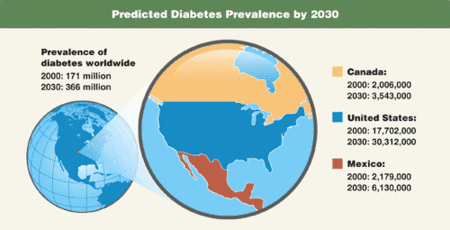Diabetes in Ontario: 69% increase since 1995
At current rate, 10% of Ontario’s population will have diabetes by 2010.
In 2004, the World Health Organization predicted that the global diabetes prevalence would be 6.4% of the population by 2030, a 60% increase from 1995.
Data from a new study by researchers at the Institute for Clinical Evaluative Sciences, Ontario, Canada, indicates that the age- and sex-adjusted prevalence of diabetes in Ontario adults has already increased 68.6% since 1995, a prevalence of close to 9% of the population.
“We found a 25% reduction in mortality among diabetes patients over the last decade, and physicians can therefore be reassured that they are taking better care of their diabetes patients,” said Lorraine Lipscombe, MD. “However, our finding that diabetes rates have increased by 69% should alert physicians to the real risk of diabetes in our population and to take every opportunity to counsel high-risk patients who don’t yet have the disease about diabetes prevention.”
The results of the population-based study, published in The Lancet, show that diabetes prevalence increased linearly from 1995 to 2005, with an average increase of 6.2% per year.
Widespread prevalence
Because there was no evidence that rates are slowing down, “policymakers will need to better plan for the rising burden of diabetes on our health care resources,” Lipscombe, a research fellow at the institute, said in an interview with Endocrine Today. “Diabetes is a costly disease, requiring chronic lifelong health care in the form of regular multidisciplinary care, multiple medications and treatment of complications. However, given the magnitude of the problem, with almost 10% of the population expected to be affected within the next few years, there is also an urgent need for better, population-based diabetes prevention strategies.”
Lipscombe and her colleague Janet E. Hux, MD, gathered data from the government-funded Ontario health plan, which is available to all residents and therefore representative of almost all Ontarians. Data were available from April 1991 to March 2005. For diabetes prevalence, the number of people recorded in the Ontario Diabetes Database was used.
There was an 81.6% unadjusted increase in the crude prevalence of diabetes in Ontario adults between March 1995 and March 2005 (P<.0001). Although the population of this area only increased 17% during this time period, the number of people with diabetes increased 113%.
“Although diabetes rates remained high among older people [aged 50 years or more], the greatest rise in diabetes was seen in younger people [aged 20 to 49], with a 94% increase in the last 10 years,” Lipscombe said. “This is of particular concern, as young people have longer to live with the disease and will have more opportunity to develop complications.”
|
|
Specific populations
Young women had a 108.2% increase in the prevalence of diabetes compared with an 81.4% increase in young men (P<.0001). The increases among men and women aged 50 or older were similar.
There was a decrease in mortality due to diabetes. The age- and sex-adjusted death rate in people with diabetes fell about 25% between 1995 and 2005 (P<.0001). This was consistent throughout all age groups but was greater among younger age groups than among older ones (P=.0002).
The researchers said that the population of Ontario might skew the results because it has a high rate of immigration from regions with more susceptible populations, such as south Asia. “It is important to ensure that we provide culturally sensitive education on diabetes prevention to target high-risk ethnic populations.”
After ten years, the prevalence of diabetes in Ontario has already surpassed the prevalence that the WHO predicted would take 35 years. Lipscombe said that the study’s findings should indicate to the public that “the risk of diabetes among Canadians is increasing greatly and is likely related to our poorer lifestyle and rise in obesity rates.
“The public needs to be aware of the risk factors for diabetes and should make every effort to maintain healthy eating habits and regular physical activity,” Lipscombe said. – by Leah Lawrence
For more information:
- Lipscombe L, Hux JE. Trends in diabetes prevalence, incidence, and mortality in Ontario, Canada 1995-2005: a population-based study. Lancet. 2007;369:750-756.

